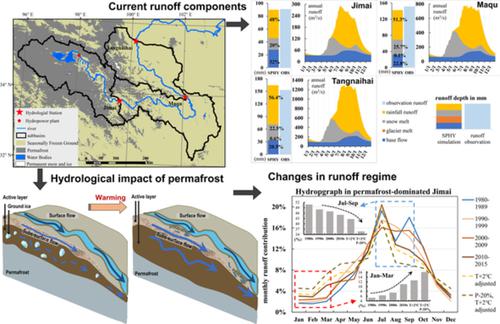当前位置:
X-MOL 学术
›
Hydrol. Process.
›
论文详情
Our official English website, www.x-mol.net, welcomes your
feedback! (Note: you will need to create a separate account there.)
Response of runoff components to climate change in the source-region of the Yellow River on the Tibetan plateau
Hydrological Processes ( IF 2.8 ) Pub Date : 2022-06-08 , DOI: 10.1002/hyp.14633 Ting Zhang 1 , Dongfeng Li 1 , Xixi Lu 1
Hydrological Processes ( IF 2.8 ) Pub Date : 2022-06-08 , DOI: 10.1002/hyp.14633 Ting Zhang 1 , Dongfeng Li 1 , Xixi Lu 1
Affiliation

|
Climate change will likely increase the total streamflow in most headwaters on the Tibetan Plateau in the next decades, yet the response of runoff components to climate change and permafrost thaw remain largely uncertain. Here, we investigate the changes in runoff components under a changing climate, based on a high-resolution cryosphere-hydrology model (Spatial Processes in Hydrology model, SPHY) and multi-decadal streamflow observations at the upstream (Jimai) and downstream stations (Maqu and Tangnaihai) in the source-region of the Yellow River (SYR). We find that rainfall flow dominates the runoff regime in SYR (contributions of 48%–56%), followed by snowmelt flow (contributions of 26%/23% at Maqu/Tangnaihai). Baseflow is more important at Jimai (32%) than at the the downstream stations (21%–23%). Glacier meltwater from the Anyê Maqên and Bayankala Mountains contributes negligibly to the downstream total runoff. With increasing temperature and precipitation, the increase in total runoff is smaller in the warm and wet downstream stations than in the cold and dry upstream station. This is because of a higher increase in evapotranspiration and a larger reduction in snowmelt flow in the downstream region in response to a warming climate. With temperature increase, there is less increase in rainfall flow in the downstream region due to increased water loss through evapotranspiration. Meanwhile, the decline in snowmelt flow is larger further downstream, which can negatively impact the spring irrigation for the whole Yellow River basin that supports the livelihoods of 140 million people. Importantly, we find that baseflow plays an increasingly important role in the permafrost-dominated upstream region with atmospheric warming and permafrost thaw, accompanied by decreased surface flow. These findings improve our current understanding of how different hydrological processes respond to climate change and provide insights for optimizing hydropower and irrigation systems in the entire Yellow River basin under a rapidly changing climate.
中文翻译:

青藏高原黄河源区径流成分对气候变化的响应
未来几十年,气候变化可能会增加青藏高原大部分源头的总流量,但径流成分对气候变化和永久冻土融化的反应在很大程度上仍不确定。在这里,我们基于高分辨率冰冻圈水文模型(Spatial Processes in Hydrology model,SPHY)和上游(集麦)和下游站点(玛曲)的多年代际径流观测,研究了气候变化下径流成分的变化和唐乃海)在黄河源区(SYR)。我们发现降雨流量在 SYR 的径流中占主导地位(贡献率为 48%–56%),其次是融雪流量(在玛曲/唐奈海的贡献率为 26%/23%)。基流在集麦(32%)比在下游站点(21%–23%)更重要。Anyê Maqên 和 Bayankala 山脉的冰川融水对下游总径流的贡献微乎其微。随着气温和降水的增加,温湿下游站总径流量的增加小于上游冷干站。这是因为随着气候变暖,下游地区的蒸发量增加较多,融雪流量减少较多。随着温度的升高,由于蒸发蒸腾造成的水分流失增加,下游地区的降雨量增加较少。同时,下游的融雪流量下降幅度更大,这可能会对支撑1.4亿人口生计的整个黄河流域的春季灌溉产生负面影响。重要的,我们发现,随着大气变暖和多年冻土融化,基流在以多年冻土为主的上游地区发挥着越来越重要的作用,并伴随着地表流量的减少。这些发现提高了我们目前对不同水文过程如何响应气候变化的理解,并为在快速变化的气候下优化整个黄河流域的水电和灌溉系统提供了见解。
更新日期:2022-06-08
中文翻译:

青藏高原黄河源区径流成分对气候变化的响应
未来几十年,气候变化可能会增加青藏高原大部分源头的总流量,但径流成分对气候变化和永久冻土融化的反应在很大程度上仍不确定。在这里,我们基于高分辨率冰冻圈水文模型(Spatial Processes in Hydrology model,SPHY)和上游(集麦)和下游站点(玛曲)的多年代际径流观测,研究了气候变化下径流成分的变化和唐乃海)在黄河源区(SYR)。我们发现降雨流量在 SYR 的径流中占主导地位(贡献率为 48%–56%),其次是融雪流量(在玛曲/唐奈海的贡献率为 26%/23%)。基流在集麦(32%)比在下游站点(21%–23%)更重要。Anyê Maqên 和 Bayankala 山脉的冰川融水对下游总径流的贡献微乎其微。随着气温和降水的增加,温湿下游站总径流量的增加小于上游冷干站。这是因为随着气候变暖,下游地区的蒸发量增加较多,融雪流量减少较多。随着温度的升高,由于蒸发蒸腾造成的水分流失增加,下游地区的降雨量增加较少。同时,下游的融雪流量下降幅度更大,这可能会对支撑1.4亿人口生计的整个黄河流域的春季灌溉产生负面影响。重要的,我们发现,随着大气变暖和多年冻土融化,基流在以多年冻土为主的上游地区发挥着越来越重要的作用,并伴随着地表流量的减少。这些发现提高了我们目前对不同水文过程如何响应气候变化的理解,并为在快速变化的气候下优化整个黄河流域的水电和灌溉系统提供了见解。











































 京公网安备 11010802027423号
京公网安备 11010802027423号